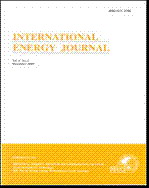ThaiScience
ThaiScience
INTERNATIONAL ENERGY JOURNAL
Volume 20, No. 04, Month DECEMBER, Year 2020, Pages 611 - 620
Hydrolysis of microalgae spirulina platensis, chlorella sp., and macroalgae ulva lactuca for bioethanol production
Kusmiyati Kusmiyati, Agnes Heratri, Sinju Kubikazari, Arif Hidayat, Hadiyanto Hadiyanto
Abstract Download PDF
Algal bioethanol is a renewable alternative fuel for gasoline that resulted in no disruption in food sources. This study investigated the effect of acid hydrolysis using H2SO4 on microalgae (Chlorella sp. and Spirulina platensis) and a macroalga (Ulva lactuca) with varying acid concentrations, temperatures, and hydrolysis time. The acid hydrolysis was carried out followed by separated hydrolysis and fermentation method (SHF). The hydrolysis process was used to break down the cell walls of algae and to convert complex carbohydrates from the cell wall into simple sugars. The Chlorella sp., Spirulina platensis, and Ulva lactuca were hydrolyzed with H2SO4 concentration of 0.5–2 N. The results showed that the highest total sugar concentration of Ulva lactuca biomass was 12.85% (v/v) when using hydrolysis of 2 N H2SO4. However, for Spirulina platensis and Chlorella sp resulted only 4% (v/v) and 10% (v/v), respectively. The results are in agreement with proximate carbohydrate analysis that showed the highest carbohydrate of 74.82% on Ulva lactuca was obtained as compare to that on Spirulina platensis and Chlorella sp. of 53.85% and 55.39%, respectively. Thus, Ulva lactuca was further investigated to determine the effects of hydrolysis time from 60 to 120 min at different temperatures of 40 –100°C. The maximum total sugar concentration (23.04%; v/v) was obtained using 2 N H2SO4 at 100°C for 60 min. The fermentation time on bioethanol production was also investigated for Ulva lactuca hydrolysate (2 N H2SO4 at 80°C for 60 min) at a different time of 24–72 h. The highest bioethanol concentration (1.45%; v/v) was obtained at a fermentation time of 72 h. This study indicated that acid hydrolysis is useful for rupturing the cell walls of Chlorella sp., Spirulina platensis, and Ulva lactuca for fermentative bioethanol production.
Keywords
acid hydrolysis, bioethanol, Chlorella sp., Spirulina platensis, Ulva lactuca.INTERNATIONAL ENERGY JOURNAL
Published by : Asian Institute of Technology
Contributions welcome at : http://www.rericjournal.ait.ac.th
